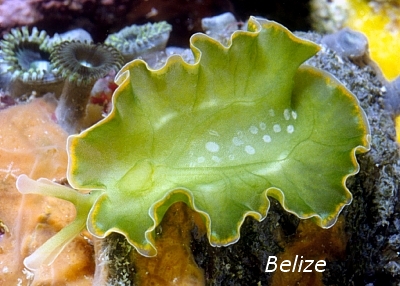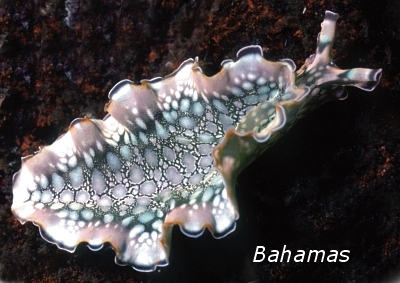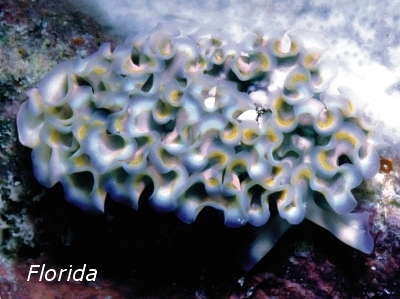Re: What's wrong with Elysia clarki?
September 7, 2006
From: Angel Valdes


Concerning message #17695:
Dear Bill,
Thank you for initiating a discussion on the validity of E. clarki in the Forum. After reading your comments as well as the original description of this species, there are several things that come to mind. I agree that very often species are described based on a single population and this is common practice, especially in cases in which material is not readily available, or the species is rare. In this case though, I do not quite understand why the authors did not examined specimens from other populations throughout the Caribbean. Elysia crispata is the most common Caribbean opisthobranch. It is found in the upper subtidal, so no diving is required to collect specimens. There are dozens of photos and specimens available in numerous museum collections and this is the only Caribbean species consistently found by amateurs with limited experience collecting opisthobranchs. So, it would be very easy for anyone to gather a substantial collection of specimens throughout the Caribbean.
The reasons for the synonimization of E. clarki with E. crispata are not stated in detail in our book because of limited space. However I would like to provide here a more complete explanation. I have been collecting specimens of E. crispata for the last few years and I have now a sizable collection including material from Florida, Costa Rica, Panama, Curaçao and the US Virgin Islands. I have also examined specimens and photographs provided by Jeff Hamann from Honduras, Belize, Bahamas, Aruba and Jamaica. My conclusion is that the characters used to separate E. clarki from E. crispata are variable. First of all, the color and the complexity of the parapodia folding is extremely variable within populations and as far as I can see there is no correlation with geographic location. We have illustrated a little bit of the variability in our book, but there are many more color patterns that we have no space to include.
Regarding the anterior fusion of the parapodia, I have included in this message a photo of a specimen of E. crispata from a reef environment in Belize in which the parapodia are not fused anteriorly, and a photo of a specimen from a mangrove environment in Florida with the parapodia fused together. I also attached another photo of a specimen from the Bahamas resembling the original description of E. clarki, but with the parapodia fused anteriorly. I have not seen branches of the digestive gland in the foot sole of the Florida specimens I collected.
Regarding genetic differences, Pat Krug et al. have recently presented a paper in the American Malacological Society meeting in Seattle, looking at generic variation of several species of Caribbean Elysia. I quote from their abstract: "In E. crispata, private ancestral haplotypes were also recovered from most sites that were 6-8% divergent. Floridian specimens of E. crispata were recently described as a new species based on local adaptation and genetic distance, but our data suggests each island cluster may harbor a derived lineage, making descriptions premature until a full phylogeographic analysis can be completed."
I think the description of E. clarki is premature and I do not see consistent morphological differences between the Florida population and other Caribbean populations. The name E. clarki remains available and it could be reintroduced at any time but I strongly believe that a review of numerous Caribbean populations from different environments and geographic locations using morphological and molecular tools is the only way to provide enough evidence to maintain E. clarki as a valid species. In the meanwhile it is my opinion that it should be considered a synonym of E. crispata.
Best regards,
Angel
avaldes@nhm.org
Valdes, A., 2006 (Sep 7) Re: What's wrong with Elysia clarki?. [Message in] Sea Slug Forum. Australian Museum, Sydney. Available from http://www.seaslugforum.net/find/17766
Dear Angel,
Thanks for your response. The photo from Belize you have sent is probably from the same series as the one already on the Forum [message #1656]. I added a note in May this year to that message saying it may be E. clarki, but in that photo the parapodial gap is not clear. Your photo definitley shoa the gap. My information was that this was a mangrove specimen, which would fit with E. clarki, not a reef specimen as you suggest.
This brings up an important point in this discussion. The only photo I had seen of this Belize form before today did not show either of the two points which seem critical in identifying these species externally - the parapodial gap and the digestive gland in the sole of the foot as I have discussed in earlier messages. You mention there are many photographs available of this common animal[s] which could be examined, but I suspect most if not all available photos will not clearly show these two features. When this topic first arose I searched the Forum, and all the published literature and websites I could find looking for photographs to see these features without success. In fact for such a common animal, it was extremely difficult to find an illustration or written description clearly describing the external morphology of E. crispata including that the rather vital point that the parapodia are fused anteriorly. So although it may be common, information on its salient points are not easy to find. One way would be to alert the many interested amateurs throughout the Caribbean to look out for these differences. I guess that is what I found disappointing about your decision in your excellent book, to effectivley censor E. clarki from the minds of the many readers your book will surely receive. It would have been a perfect way to encourage them to give Elysia 'crispata ' more than the normal passing glance they would give to something considered so common..
Concerning colour and parapodial folding - I specifically mentioned that these points were probably not that helpful in a discussion on these species because of the difficulty in quantifying them. Similarly, Pierce et al mention the way E. clarki rests with its parapodia open flat, a bit like descriptions of the mangrove dwelling species Elysia leucolegnote in the Indo-West Pacific. Although I think this behavioural difference and degree of parapodial folding are probably good characters, discussing them at present, would bog us down in trying to quantify the unmeasurable.
What I said we should do is try and test the two important external characters - the parapodial fusion and digestive gland ducts in the sole of the foot. Unfortunately none of your photos show both those features so we are no further ahead. Concerning habitat specificity. My advice is that the Belize animal is from a mangrove habitat so one of us is wrong. Concerning the Florida animal which looks to me like a 'typical' well-folded E. crispata - as I am at pains to repeat often, I have no personal experience with these animals, or the Caribbean, so I cannot comment on whether that is an unusual find or not, but from the writings of Pierce and his co-workers, it would seem to be.
Concerning the genetics. I remember a couple of years ago reading that there was more genetic variability in a troop of chimps in West Africa than in the whole world population of Homo sapiens. While these genetic analyses are very interesting, it seems we shouldn't defer to them when we have, what seem to me, to be good external morphological characters. I am not belittling genetics and DNA studies, but we have to be careful as morphologists not to consider them to be the answer to all our unanswerables. After all, geneticists and DNA workers spend as much time commenting on each other's work as morphologists do, so they can't have all the answers.
I am happy to invite participants to send photos from anywhere in the Caribbean of Elysia crispata and Elysia clarki, but there is a rule. All photos would have to be in a set of 2 or 3 showing the whole animal from above, the sole of the foot and the front of the parapodia to show whether it is fused or separate. If there is only one species, then surely we will find animals with fused parapodia and green patches of digestive gland in the sole of the foot.
Best wishes,
Bill Rudman
Related messages
-
Relationship of Elysia diomedea and E. crispata
From: Patrick Krug, October 6, 2008 -
Elysia clarki feeding practices
From: Adam D'Agosto, December 6, 2007 -
Elysia clarki and E. crispata in Florida
From: Skip Pierce, October 10, 2007 -
Re: Elysia crispata in Cozumel, Mexico
From: Skip Pierce, February 2, 2007 -
Re: Elysia crispata in Cozumel, Mexico
From: Jim Lyle, February 2, 2007 -
Re: Elysia crispata in Cozumel, Mexico
From: Sean Kearney, February 2, 2007 -
Re: Elysia crispata in Cozumel, Mexico
From: Skip Pierce, February 1, 2007 -
Elysia crispata in Cozumel, Mexico
From: Sean Kearney, January 29, 2007 -
Elysia clarki feeding references
From: Nicholas Curtis, January 29, 2007 -
Re: What's wrong with Elysia clarki?
From: Colin Redfern, September 9, 2006 -
Re: What's wrong with Elysia clarki?
From: Colin Redfern, September 9, 2006 -
Re: What's wrong with Elysia clarki?
From: Skip Pierce, September 8, 2006 -
Re: What's wrong with Elysia clarki?
From: Skip Pierce, September 1, 2006 -
Re: Damaged Elysia crispata
From: Nick Curtis, August 31, 2006 -
What's wrong with Elysia clarki?
From: Bill Rudman, August 30, 2006 -
Elysia diomedea & E. clarki in home aquarium?
From: Matt Pedersen, May 30, 2006 -
Elysia clarki breeding in the home aquarium
From: Matt Pedersen, May 30, 2006 -
Elysia clarki, E. diomedea and E. crispata
From: Bill Rudman, May 30, 2006 -
A new Elysia from Florida
From: Bill Rudman, May 30, 2006 -
Lettuce Sea Slug behavior and feeding
From: Patrick Glenn, April 13, 2006 -
What to feed Elysia crispata?
From: Alexandra Ahnide, April 11, 2006 -
Elysia crispata feeding and babies
From: Willem Bermel, January 31, 2006 -
Re: Colour in Elysia (again)
From: Anne DuPont, November 7, 2005 -
Re: Lettuce sea slug - breeding success
From: Vincent, June 27, 2003 -
Lettuce sea slug - breeding success
From: Rick Hahn, May 31, 2003 -
Re: Gene transfer - Elysia crispata
From: Skip Pierce, May 5, 2003 -
Re: Algal genes in Elysia crispata
From: Philip Cromwell, May 3, 2003 -
Re: Elysia crispata and algal genes
From: Skip Pierce, May 3, 2003 -
Algal genes in Elysia crispata
From: Skip Pierce, May 2, 2003 -
Elysia crispata babies
From: Joe Bongiorno, December 30, 2002 -
Re: Baby slugs!
From: Joe Bongiorno, December 18, 2002 -
Re: Baby slugs!
From: Joe Bongiorno, December 10, 2002 -
Bifid rhinophores in Elysia crispata
From: Anna L. Bass, September 12, 2002 -
Elysia crispata? in aquaria
From: Ash, April 1, 2002 -
Re: Baby slugs! - Elysia crispata
From: Jeff Zimmerman, June 4, 2001 -
Re: Baby slugs! - Elysia crispata
From: Jeff Zimmerman, March 22, 2001 -
Baby slugs!
From: Jeff Zimmerman, March 17, 2001
